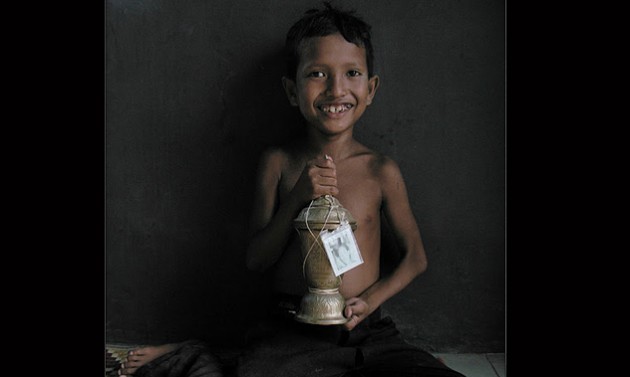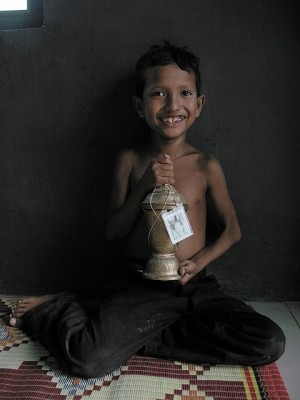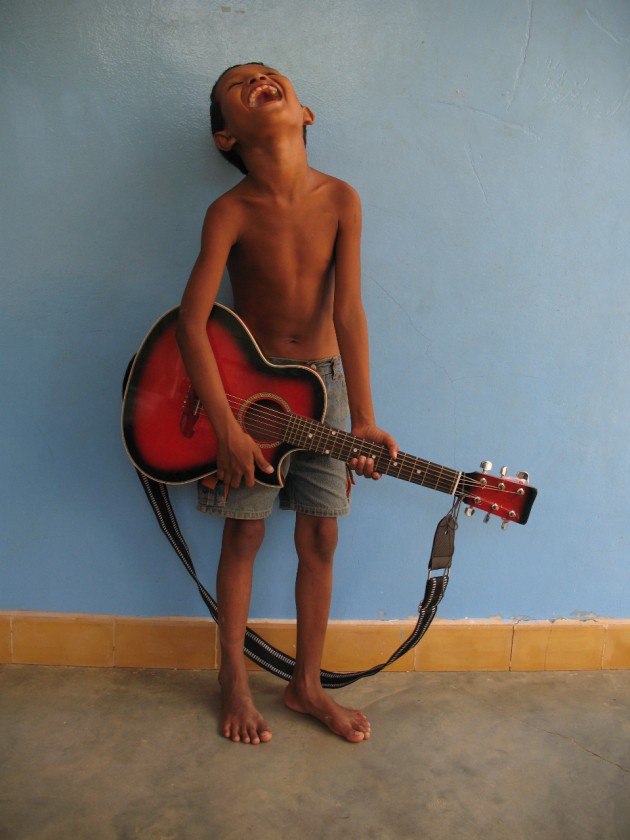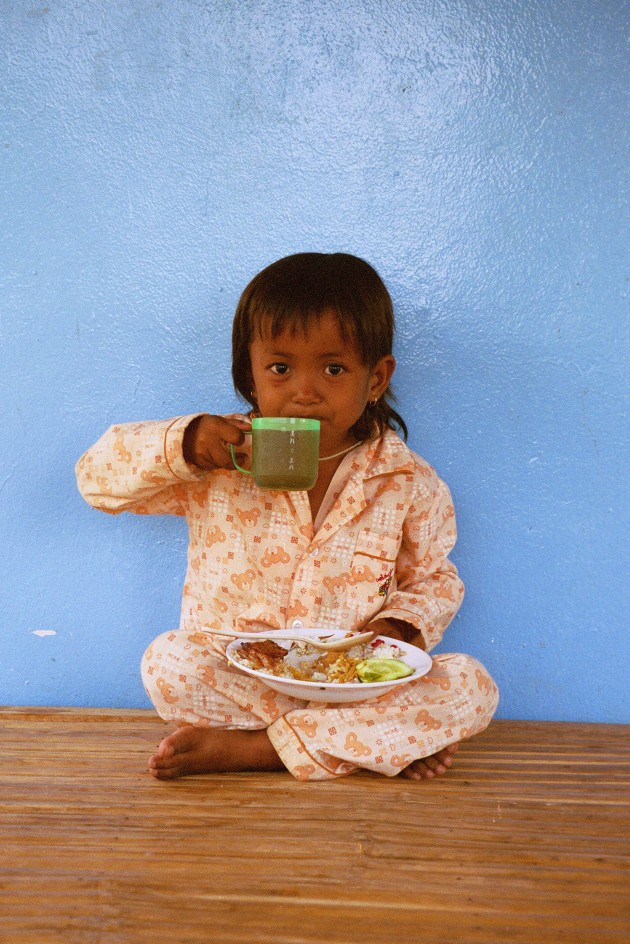
Gail Gutradt
[C]reating families, families of choice rather than of birth, is a common theme in contemporary society. Fueled by our diasporas, our flights from the intolerant or the intolerable, we seek to refashion connections, to build a sense of belonging. Today, on a dusty road in rural Cambodia, I am traveling to join a community of adults and children who came together to find the safety, love, and acceptance that many of us can only long for in our natural families.

The Wat Opot Family Center is located amid rice fields and villages, about an hour south of Phnom Penh. I have come as a volunteer from the United States, to live with children orphaned by the AIDS epidemic that has raged in Cambodia since the 1990s. Currently HIV/AIDS infects an estimated 130,000 people out of a population of 14 million. The infection rate here is among the highest in Asia, and approximately one-third of new cases are among children born to HIV-infected mothers. Interventions exist that can virtually eliminate transmission to newborns, but the Cambodian AIDS Authority reports that only 30 percent of mothers deliver in health care facilities. Of these, only a quarter are tested for HIV.
[I]n Phnom Penh, I visited Tuol Sleng, the haunting prison where the Khmer Rouge tortured thousands during the Cambodian genocide. The faces of the lost stared back at me from the walls, from grainy prison photographs. In the pa cha, the crematorium at Wat Opot, I am looking at other portraits now, but instead of prison numbers, here are people’s names and the date when they perished of AIDS. And here are stories, remembered and retold, because the dead are family to the living.
Wayne Dale Matthysse, the Director and co-founder of Wat Opot, can tell you the stories behind each of these portraits. He speaks of Mr. Phoung Sokha, the village carpenter who built the crematorium, not yet knowing he had AIDS, and became one of the first to be cremated here. Wayne nursed each of these people during the last days of their illness, held them as they died, and once experienced a child’s soul as it departed his body. “I literally saw him coming up and out of those big dark eyes, like a cool breeze on a midsummer’s night, passing through me….as his eyes closed gently behind his departing spirit.” After they die, Wayne salvages whatever image is available, sometimes only a tiny photo from an identity card, and creates a memorial portrait to hang in the Family Room. He says the work gives him time to meditate on the life of each patient who dies. It is his final loving service to those he has tended in life and in death.

[A]rriving at Wat Opot this morning, dusty and apprehensive, I am greeted first by Mr. Tia. He is eight years old. He runs out from the crowd of children, with an enormous toothless grin, and throws his arms around my knees. My heart is his. My uneasiness vanishes as the children help me unpack and settle in, fascinated by my First World necessities, searching my bundles and pockets for toys and candy.
Now, after dinner, Wayne and the children and I are walking slowly towards the crematorium for a the brief memorial service that is held there every evening. The children will offer incense to the souls of the dead, chant a prayer invoking the name of the Buddha, and sing a Christian hymn of thanks for the lives of their loved ones. The children call out, “Mr. Wayne go pa cha,” and fall in behind us. They are an unruly group of various ages, running and singing and jostling each other. Children hang in clusters from our arms and hands. I need more fingers. In the Family Room the children sit on the floor, opposite the pictures of their parents and friends. I hear from Wayne that after each cremation the children help select and wash the bones of the dead for the crematory urns. Each urn is carefully tied with a web of string and bears a tag with a name and tiny portrait.
The photos on the wall of the pa cha are only some of the faces of the AIDS epidemic. All around me are children who are either orphaned or infected by the AIDS virus. My new friend, Mr. Tia, sits close to me. He arrived four years ago, a stowaway in the ambulance that carried his mother’s body. She had been bound and beaten nearly to death, and died the next day. When the attendants opened the doors, out jumped a skinny little boy with no front teeth. The ambulance was gone before Wayne could find out what village they came from. And so Mr. Tia came to live at Wat Opot.

Now, leaving my side, Tia takes his mother’s urn from the glass case. He holds it out so I can see her picture and says simply, “Mama.” He smiles his vast, guileless smile, and I get the sense that he is introducing us. Through the unthinkable, the indescribable pathos of this moment, there is also a sweetness. This little man knows just where to find his mother and wants to introduce her to his new friend, and that knowledge comforts him.
If this seems incomprehensible, a small boy finding solace with his mother’s ashes, consider that it is his only connection to something that could by any stretch of the imagination be called his own. Judging by his mother’s wounds, every connection, every trace of what we in a more benevolent world would call home was stripped away before he climbed into the ambulance that night, and, with his mother’s death, so too the last trace of family. And yet he smiles.
In America, when I give talks about Wat Opot, adults always ask: “Did you have a bathroom?” ” Where do they get their funding?” and, ” What kind of camera did you use?” These are safe questions asked from a distance. Third grade children ask, “You said these kids are poor. How come they don’t look poor?” And, “If they know they are going to die, how come they look so happy?” Children empathize from their own vulnerability. It is always a joy to talk with youth groups, not to show them what one nervous boy called “kids with sores,” but images of children who look like them, children they might want to know and play with. These Western children begin to look at others not through the filter of “What can we give them?” with its subtle message that somehow “we” are superior, but simply as fellow beings.
Here at Wat Opot there are currently sixty-four children like Tia. Twenty-three are HIV-positive, the rest have been orphaned by AIDS. They live with two dozen HIV-positive adults. Each story here begins with profound loss, for these are the poorest of the poor, the outcasts of their society, the throwaways. Whether, as is common, the disease was brought home to a poor or middle-class agrarian family by a husband who had unprotected sex with a prostitute, or caught by a woman forced into the sex trade by poverty, the result is the same. Their neighbors, even their own families may, in terror and ignorance, ostracize them, stone them, or worse.
Cambodia is still a society without government programs for the elderly. Aging grandparents who had counted on their adult children to support them in their old age suddenly find themselves responsible for young grandchildren. Why put scarce resources into raising a doomed child, when there are others to feed? Wayne understands, and does not judge them.
Wayne Dale Matthysse was a Marine Corps Medic in the Vietnam War. In 2000 he met Vandin San, a quietly charismatic young Cambodian man working for the Catholic relief organization, COERR. Wayne had returned to Southeast Asia to work with street kids in Phnom Penh, and Vandin was training monks to educate villagers in patient care and AIDS awareness and prevention. Vandin recalls that, “In the beginning, the Ministry of Cults and Religion did not approve of the monks’ participation. It was not proper for monks to talk about sex.” He lobbied district and provincial governors, who petitioned the Ministry to support the project.
One day, Wayne remarked that he had seen scant evidence of an AIDS epidemic in Cambodia. “Why would they tell you?” Vandin replied. “What do you have to offer them? Come, I will show you AIDS in Cambodia.”

Wayne holds Mr. Chanthol. Chanthol had recently learned of his mother’s death from TB and AIDS.
Thus began a collaboration between a Cambodian Buddhist and an American Christian that was to evolve into Partners in Compassion, a non-sectarian organization dedicated to caring for people affected by HIV/AIDS. Building on land donated by a Buddhist pagoda named Wat Opot, Wayne and Vandin opened a small clinic and hospice for people dying of AIDS. Here, they trained home care teams, consisting of monks and laypeople, who travel through villages teaching about AIDS, bringing medical care, food, and emotional support. So it went for several years, as hundreds of people were nursed and died and were given funerals in the crematorium which Vandin constructed on the land. “Sometimes two or three patients, adults and children, died in a day,” he recalls.
The picture changed radically in 2003 when Medecins Sans Frontiers (Doctors Without Borders) opened a clinic in Takeo province, close to Wat Opot. Relying on the Partners in Compassion home care teams to support families with AIDS in the villages, MSF began a program of distributing anti-retroviral medicines to victims of AIDS, including residents of the Wat Opot Project.
Today, Wat Opot has evolved from a hospice for the dying into a vibrant community where children with and without the AIDS virus eat, sleep and play together as family. Seeing this, villagers have become less fearful of living near people with AIDS.
In contrast, many people elsewhere in Cambodia fear AIDS patients and do not understand how the disease is transmitted. A recent visitor to Wat Opot from Phnom Penh, an educated Khmer woman of about 25, was terrified of eating food cooked by people with AIDS, lest the cook might have cut herself and a drop of her blood fallen into the food. This same woman was so clearly uneasy at the thought of touching children with HIV that she busied her hands with her knitting whenever children were nearby. There is much educating still to do.
Wat Opot is virtually unique in Cambodia and in other places where segregation of HIV-positive children is common. For the children themselves, and as an example for the rest of us, the benefits are profound. Here, they are hugged, wrestled with, teased, taught, challenged, encouraged and loved. Most of all, they are accepted into the human family, not merely warehoused in orphanages. Adoptions are rare and not sought after. Wayne explains, “I don’t want the ones who aren’t adopted, the older ones, those with AIDS, the ones who maybe aren’t as pretty, to feel left behind. They’ve had enough rejection. I want the kids to think of this as their family, a place to come home to.”
The handsome campus buildings, built with local labor, include the original hospice, which is now a temporary dormitory for the growing population of children, a three-room schoolhouse, a moated agricultural center with chickens, ducks and a ponderously pregnant sow, a weaving center where skilled silk weavers can earn a living selling their wares in the nearby market, and a stunning circular dining room and kitchen with a soaring pointed roof that houses a small stage where the kids perform karaoke.
Everywhere there are bright flowers, mango trees, chickens, ducks and haughty Guinea hens. There are small ponds for the children to fish in, more for fun than for food, and to comfort the soul with the sight of water during the relentless dry season. Wayne delights in order and beauty, and wants to instill that love in his children.

All of these children have watched friends and parents die of AIDS. Still, they are beginning to understand that now, with care, they have an excellent chance to live near-normal lives. The children attend elementary and secondary school in the community, and Wat Opot has its own school, where teachers give the little kids a head start, and tutor older children who have never been to school. Boys and girls are learning to sew, giving them an option to earn money in the garment industry if they should move to Phnom Penh. There are English language classes in the evening. The future comes alive by making plans, getting an education, studying English, learning a trade that can help them transition to the world. There are plans for a vocational school, computers, and a language lab.
As the children mature, they will have questions about sexuality, marriage, children of their own. As Wayne says, “This is the first generation of children growing up with HIV/AIDS, the first for whom we can even talk about a future. These kids are writing the book.”
[W]at Opot’s basic monthly expenses of US$3000 to $4000 are miniscule when compared to many aid organizations, but sometimes money is scarce. Funding comes mostly from small foundations and private donors. A Taiwanese woman who once volunteered has a birthday party and asks for contributions in lieu of presents. Another volunteer has an exhibit of photographs and donates the proceeds. Friends talk to friends who forgo Christmas presents to send donations. Visitors leave checks. Church groups hold pot luck suppers. Miracles happen. It comes together, always enough, never more than they need, sometimes at the last minute. When food is scarce, the children hunt frogs, birds, and fat rice rats.
At Wat Opot, the sense of family is not built on money, but on appreciating the things that money cannot buy. His faith has led Wayne to vow never to ask for money, and to trust that what is needed will be given. Recently, he and Vandin have begun searching for enterprises that can be run by the residents, that can make the community more self-sustaining. Five large ponds await the rainy season floods, when they will be seeded with fish to sell in the market.
Wayne draws no salary, owns almost nothing. He contributes his veteran’s benefit to the cause, and sleeps on a bamboo bed in a sheltered outdoor dining area called Chhang’s Place, named after a beloved little boy who perished of AIDS. He prefers sleeping outdoors, even during the rainy season. “Out here, I don’t have to strain to hear a child cry. I know everything that’s going on.”
By what alchemy do children orphaned by AIDS become part of their new family? Asked about his role, Wayne answers, “Don’t write about me. It’s their parents that died. I just happened to be there with them. That’s what created Wat Opot. That’s what made us a family…the things that we’ve gone through together.”
[A]s the months went by, I learned more about the children, and about the varieties of human experience that forge a new family.
I learned about Baby Mai. She is six months old. Like her mother, Baby Mai has been diagnosed HIV-positive. Her mother must work to feed her own aged parents, who are too feeble to look after the baby. An infected couple at Wat Opot, who have no children of their own, agreed to look after Baby Mai. The joy of a little girl transformed the new parents, and the baby’s mother visits when she can. Ultimately, if her own mother cannot care for her, she may be adopted by the new couple and remain at Wat Opot. Meanwhile, she has medical care, and is the darling of her extended family.
I got to know Chandara, whose mother has AIDS. He is an older boy who came to Wat Opot to go to school. He tried to fence a stolen bicycle at the bike store in the next village. The fancy bike belonged to the son of the bike store owner. Theft in this close-knit community is a serious betrayal. Before a meeting of the other boys his age, Chandara promised to do better. The boys listened gravely, eyes discretely averted, weighing Wat Opot’s reputation in the village against the repercussions of expulsion on their friend’s future. Each boy knew that he himself could be the one on trial. Finally, they agreed to give Chandara a last chance, each boy stepping into the role of father and older brother. In this way, family members assume responsibility for each other.
And, I met Srey Nak, a terrified little girl of three. She and her mother were found on the streets of Phnom Penh. Her mother was near death. Srey Nak sat on the end of her mother’s hospital bed for months while her mother slowly died. Her traumatized expression never changed, and she would scream uncontrollably whenever anyone tried to comfort her. Slowly, she has found friends. Slowly she has begun to smile. The first time she let me hold her she peed on my lap, but to me it felt as if the sun had come out. Now she plays happily with two little girls her own age. The children heal each other.
[I] was taking pictures one day of Pesei and his sister Srei Lec with their yei, their grandmother, who was visiting from the provinces. One of the other little girls, Srey Oun, wanted to be in the photo. “Why?” I asked her, “She’s not your yei.” Pesei put his arm around Srey Oun and explained it to me. “But she is our family, too.” I was humbled by his compassion. I realized that the innate generosity of these children, that their grasp of the spirit of Wat Opot, is vastly more profound than my own. I long to see their homes and families, and how they will reshape their communities when they grow up.
I once asked Wayne how these sixty-four powerful personalities would do when they move outside Wat Opot to live in polite Khmer society. He answered without a pause, “I hope they will be the ones questioning authority and bringing social change.”
These days, Wayne and Vandin are discussing a new project for Wat Opot, a hospital for children with cancer and other terminal diseases. The children of Wat Opot have nursed parents and friends, and experienced death with an immediacy that few adults can comprehend. Who knows what might happen on this lovely campus, full of flowers and mango trees, when other small patients join the Wat Opot family, and are nurtured by their joy and love? In the end, the children of Wat Opot might come to understand that their experiences have taught them a kind of compassion which could, in turn, be their gift to others.

Gail Gutradt is the author of ‘In A Rocket Made of Ice’, a touching memoir of life in a Cambodian orphanage where children were just discovering that they might not die, but might instead be part of the first generation to grow up with HIV/AIDS. Her stories, articles and poems have appeared in Kyoto Journal, Utne Reader and Ashé. This, her first Kyoto Journal article, was nominated for a Pushcart Prize. Gail sadly passed away in 2016 after a long battle with cancer.